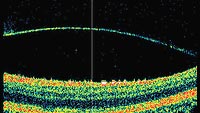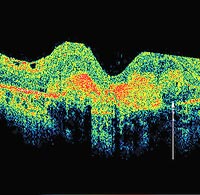Clinicians continue to discover relevant data from spectral domain OCT
In our practice at the Eye Institute and Laser Center in Manhattan, over the past several years virtually all of our patients have had an Optomap Retinal Exam (Optos, Marlborough, Mass.), and virtually all detected lesions have been subjected to critical cross-sectional analysis with the OCT Stratus (Carl Zeiss Meditec, Dublin, Calif.).
Within the last year, at least six next-generation OCTs have become commercially available. These new OCTs, known as either spectral domain (SD) or frequency or Fourier domain, represent at least an evolution – if not a revolution – with regard to in vivo retinal dissection.
 This fundus image shows the extensive macula scar surrounded by areas of hemorrhaging. The outer green box (6 mm x 6 mm in size) shows the total area scanned by the SD OCT, about 65,000 A-scans are taken in 3 seconds. Source: Sherman J |
In the original time domain (TD) OCT, a simple mirror is moved to obtain the sections. In SD OCT, a sophisticated spectrometer obtains multiple sections nearly simultaneously with a dramatic increase in the number of component A-scans obtained per second. Superior speed, resolution and sensitivity result.
Although there is agreement that the SD OCTs yield higher resolution slices and detailed 3-D reconstruction of macular (and other) pathology, it was unclear initially whether these vastly more dramatic images would result in new insights into retinal disease and consequent improved patient care.
The six new SD OCTs appear to be similar in their OCT characteristics but differ primarily in their non-OCT imaging capabilities.
The Topcon 3D OCT-1000 (Paramus, N.J.) incorporates a SD OCT with a nonmydriatic near infrared, color fundus camera. The combination of a fundus camera and OCT within the same instrument is logical and has already proven to be particularly educational in a teaching institution.
For example, State University of New York first-year students are photographed and scanned with the Topcon system. We click on the center of the disc on the color fundus photo and obtain an OCT horizontal cross section of the cup, disc and peripapillary zone. (Remarkably, many of these normal discs have obvious remnants of the persistent fetal vasculature in the vitreous anterior to the disc that is clearly visible on SD OCT but not observable with fundus photography or ophthalmoscopy.)
We click on the fovea on the 2-D fundus photo and obtain a horizontal slice through the fovea and macula. One student had a 0.2 disc diameter spot (histoplasmosis)first detected on the fundus photo. A click on the spot on the fundus photo yielded a horizontal OCT slice through the lesion revealing the thinning of retinal tissue including an attenuated retinal pigment epithelium.
Case report in teen
A 16-year-old was evaluated in the SUNY Retinal Clinic because of worsening vision in her left eye in 2005. The best corrected visual acuity was 20/20 in the right eye with a normal fundus exam; however, the VA in the left eye was only corrected to 20/200. A macular lesion was observed and appeared to be an inactive and flat scar deep in the retina. All other findings were within normal limits.
 This image demonstrates the ability of SD OCT to capture the vitreous (posterior hyaloid) as we have never been able to see with such clarity. | ||
Congenital toxoplasmosis (and other inflammatory etiologies) were considered, but the patient denied any vision reduction as a child and also denied any history of trauma. A Stratus OCT was obtained at that time, and the line scan through the lesion was interpreted as a subretinal macular scar. Normal electro-oculograms ruled out Best’s vitelliform macular degeneration.
Follow-up evaluations every 6 months were unremarkable until 2 years after the initial presentation when the teenager complained about slight worsening of the vision in the left eye. The VA was now 20/200-1, and the slight drop was explainable on the basis of macular hemorrhaging believed to be due to a choroidal neovascular membrane (CNVM).
Although the etiology remained uncertain, a consulting retinal specialist suggested Avastin (bevacizumab, Genentech), an anti-VEGF drug. A fluorescein angiogram was deemed not essential because anti-VEGF treatment works regardless of the exact location of the lesion, and the old scar would likely obscure much of the CNVM.
The most recent follow-up, 1 week after the first intraocular injection, revealed no change in visual acuity or fundus appearance. The SD OCT revealed a highly reflective (depicted in red) lesion under the macula. Because scars and CNVMs are both highly reflective, it is difficult to ascertain how much of the lesion is scar vs. CNVM.
When compared to the Stratus OCT from 2 years earlier, the submacular lesion is larger. Because blood and clear fluid are both poor reflectors of light with OCT, the dark zone perhaps represents both and is serosanguinous in nature. The SD OCT also allowed us to image the presence of a posterior vitreous detachment in incredible clarity. Additional Avastin treatment is being considered, and visual acuity, fundus photos and OCT can document regression, progression or stability.
 |  |
| This 3D image clearly displays areas of elevation throughout the macular region. The examiner has the ability to select any area of interest and view the cross-section instantly. Also of note is the imaging of the posterior vitreous detachment. | This SD OCT image reveals areas of high reflectance (shown in red), which can be attributed to either the macular scar or a CNVM, or more likely both. The area of low reflectance (shown in black/white arrow) suggests blood or serosanguinous fluid is present. |
Without doubt, SD OCTs generate remarkable images and 3-D reconstructions. The point-by-point registration of the fundus image and the OCT is ideal for both student and patient education as well as for monitoring change at any specific location.
Unanswered questions remain
Unanswered questions still abound: Will the improved axial resolution to about 6 microns (from 12 microns with the Stratus) yield important, additional clinical information in a substantial number of cases? Will the OCT eventually become the standard of care? Beyond retinal disease, will SD OCT become the standard for retinal nerve fiber layer measurements in glaucoma and in the nonglaucomatous optic neuropathies? Stay tuned.
For more information:
- Jerome Sherman, OD, FAAO, a PCON Editorial Board member, can be reached at SUNY College of Optometry; (212) 938-5862; e-mail: jsherman@sunyopt.edu. Dr. Sherman lectures for Zeiss, Optos and Topcon.
- Hanish Patel, OD, is a resident at SUNY and can be reached at (212) 938-4021; e-mail: hpatel2@sunyopt.edu. Dr. Patel has no direct financial interest in the products mentioned in this article, nor is he a paid consultant for any companies mentioned. Acknowledgments to Drs. Richard Madonna, Sherry Bass and Mark Harooni for providing select care.
